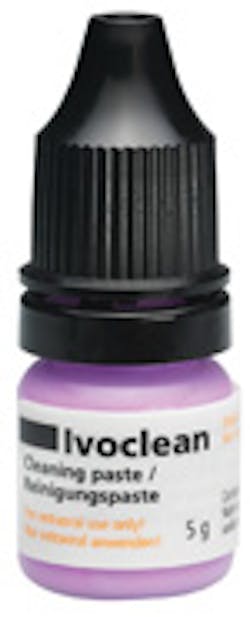A Cleaning Solution For Zirconia Oxide Restorations
By Michael DiTolla, DDS, FAGD
When Glidewell Laboratories originally released BruxZir® Solid Zirconia crowns and bridges, we knew that, while the zirconia material had many positive attributes, a couple of its properties would challenge us for the foreseeable future. I’m happy to report that great strides have since been made in overcoming these challenges.
The first issue is esthetics. The early BruxZir crowns were opaque and, therefore, best used for posterior teeth only. More recently, as we continued to increase the translucency of the material, it became possible to use BruxZir restorations for anterior crowns and bridges, especially for patients who show much wear or have broken previous PFM or all-ceramic restorations.
There are examples in Chairside magazine and on our website (www.glidewelldental.com) in which I have successfully used BruxZir crowns in the anterior, even on Nos. 8 and 9.
The second challenge was how best to cement or bond BruxZir crowns. Unlike every other all-ceramic material dentists have worked with during the last 20 years, hydrofluoric acid does nothing to zirconia oxide. Hydrofluoric acid usually works by removing a portion of the glassy matrix in a ceramic, thus “etching” it and creating micro-mechanical retention.
As we started researching this bonding issue, I stumbled across some research by Ivoclar Vivadent. It showed that zirconia oxide gets contaminated once the crown is tried in the mouth and comes in contact with saliva.
It turns out that the phospholipids in saliva contain the same phosphate groups as the zirconia primers. Furthermore, simply rinsing the saliva out of the crown does not remove the phosphate groups that are bonded to the zirconia oxide.
Decades ago, many of us were taught that a good way to clean the internal surface of an all-ceramic restoration after it was tried in the mouth was to clean it with phosphoric acid. This technique worked well. Many well-meaning dentists (myself included) also cleaned zirconia oxide this way, thinking it was the right thing to do.
Now it may not come as a shock to you but phosphoric acid contains — you guessed it — phosphates. So, instead of cleaning the saliva out of the crowns as it did in the past with other crown and bridge materials, phosphoric acid on zirconia actually worsens the problem by flooding the inside of the crown with more phosphate groups than were present in the saliva. Talk about counterintuitive!
So if water does not work and phosphoric acid makes the situation worse, how can these phosphate groups be removed from the internal surfaces of a zirconia crown? To do this, a zirconia oxide solution needs to be used to clean the crown. Today, there is only one product available — Ivoclean from Ivoclar Vivadent.
How does Ivoclean work?
Since the salivary phosphate is bonded to the zirconia oxide in the crown, we need to flood the inside of the crown with a greater concentration of zirconia oxide. Placing Ivoclean into the crown creates a concentration gradient, so the phosphates that were bonded to the crown become bonded to the zirconia oxide in the Ivoclean. After 20 seconds, the Ivoclean is simply rinsed away, creating a fresh bonding surface on the inside of the zirconia oxide crown for zirconia primers.
We now understand how dentists were able to cement zirconia oxide crowns repeatedly and still have them fall off, even though they were using a zirconia primer. If the salivary phosphates are never removed from the inside of the crown, zirconia primers will not work. So, despite repeated applications of the primers, until the original phosphates are removed from the inside of the crown, nothing else can bond there.
I now use Ivoclean on my zirconia oxide restorations, even if it looks like I have adequate retention. I simply do not like cementing crowns into place after try-in knowing there is contamination present. Ivoclar’s research also shows that Ivoclean improves the bond of cements to IPS e.max, so I clean these restorations as well prior to cementation or bonding.
Michael DiTolla, DDS, FAGD, is the director of clinical research and education at Glidewell Laboratories in Newport Beach, Calif. He lectures nationwide on both restorative and cosmetic dentistry. Dr. DiTolla has several free clinical programs available on DVD through Glidewell Laboratories or online at www.glidewelldental.com.
Past DE Issues

